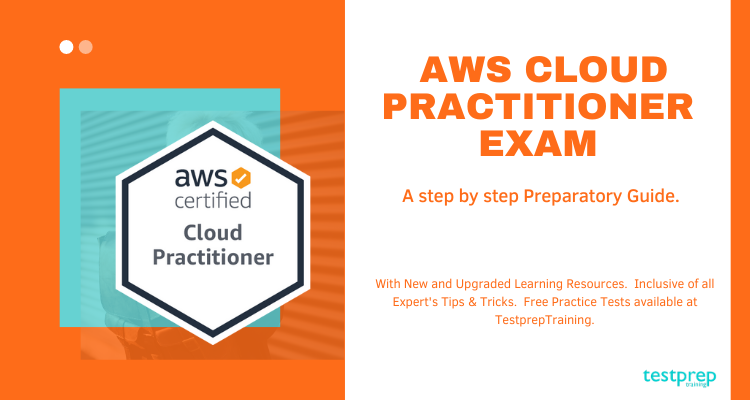The AWS Cloud Practitioner Exam is a foundational certification that is designed to validate your knowledge of the Amazon Web Services (AWS) Cloud. It is an excellent entry point for individuals who are interested in pursuing a career in cloud computing or for those who want to gain a basic understanding of cloud computing concepts.
To pass the AWS Cloud Practitioner Exam, you must have a comprehensive understanding of AWS services, architectures, and pricing models. In addition, you must have a solid grasp of cloud computing concepts such as security, scalability, and elasticity.
In this blog, we will provide you with a step-by-step guide on how to prepare for the AWS Cloud Practitioner Exam. We will cover the exam format, the topics that will be covered in the exam, and the resources that you can use to prepare for the exam. By following our guide, you will be able to prepare yourself for the AWS Cloud Practitioner Exam and increase your chances of passing it on your first attempt.
Glossary for AWS Cloud Practitioner Terminology
Here’s a glossary of some key terms and acronyms related to AWS Cloud Practitioner:
- AWS: Amazon Web Services, a cloud computing platform offered by Amazon.
- Cloud Computing: A model for delivering on-demand computing resources over the internet.
- Region: A geographical location where AWS resources are available. Each region has multiple availability zones.
- Availability Zone: An isolated location within a region that has its own power, cooling, and networking infrastructure.
- EC2: Elastic Compute Cloud, a service that provides resizable compute capacity in the cloud.
- S3: Simple Storage Service, a service that provides scalable and durable object storage.
- RDS: Relational Database Service, a service that provides managed database solutions.
- VPC: Virtual Private Cloud, a service that provides a virtual network to isolate AWS resources.
- IAM: Identity and Access Management, a service that provides control over AWS resources and users.
- ELB: Elastic Load Balancer, a service that distributes incoming network traffic across multiple EC2 instances.
- Auto Scaling: A service that automatically adjusts the number of EC2 instances based on demand.
- CloudFormation: A service that allows users to define and manage AWS resources using code.
- Lambda: A service that allows users to run code without provisioning or managing servers.
- SNS: Simple Notification Service, a service that sends notifications from AWS services to various endpoints.
- SQS: Simple Queue Service, a service that allows users to decouple and scale distributed systems and applications.
- Glacier: A low-cost storage service for data archiving and long-term backup.
- Route 53: A scalable domain name system (DNS) service for managing domain names and routing internet traffic to AWS resources.
- API Gateway: A service that allows users to create, publish, and manage APIs.
- CloudFront: A content delivery network (CDN) that delivers content to end-users with low latency and high data transfer speeds.
- KMS: Key Management Service, a service that allows users to create and manage encryption keys for their data.
This is by no means an exhaustive list, but it covers some of the most commonly used terms and acronyms related to AWS Cloud Practitioner.
Exam preparation resources for AWS Cloud Practitioner Exam
Here are some official AWS Cloud Practitioner exam preparation resources with website links:
- AWS Cloud Practitioner Essentials: This free digital course provides an overview of AWS cloud concepts, AWS services, security, architecture, pricing, and support. It is an excellent starting point for preparing for the AWS Cloud Practitioner exam. Link: https://www.aws.training/Details/Curriculum?id=27076
- AWS Certified Cloud Practitioner Exam Guide: This official exam guide covers the AWS Certified Cloud Practitioner exam’s topics and provides information on the exam format and scoring. The guide includes sample questions, practice exam questions, and recommended resources for further study. Link: https://d1.awsstatic.com/training-and-certification/docs-cloud-practitioner/AWS-Certified-Cloud-Practitioner_Exam-Guide.pdf
- AWS Certified Cloud Practitioner Practice Exams: These practice exams, available for purchase on the AWS website, provide practice questions that simulate the AWS Cloud Practitioner exam’s format and content. The exams provide explanations for correct and incorrect answers and come with a money-back guarantee. Link: https://aws.amazon.com/training/course-descriptions/cloud-practitioner-practice-exams/
- AWS Whitepapers: AWS offers a range of whitepapers that cover topics such as security, architecture, cost optimization, and compliance. These papers provide detailed information on AWS services and best practices for using them. Link: https://aws.amazon.com/whitepapers/
- AWS Documentation: AWS documentation provides detailed information on AWS services, API reference, SDKs, and developer tools. The documentation includes examples, tutorials, and code samples. Link: https://docs.aws.amazon.com/
- AWS Certified Cloud Practitioner Exam Readiness Training: This free digital course provides a comprehensive review of exam objectives and helps candidates prepare for the AWS Certified Cloud Practitioner exam. It includes videos, practice quizzes, and a final exam. Link: https://www.aws.training/Details/eLearning?id=34737
- AWS Cloud Practitioner Essentials (Second Edition): This updated version of the Cloud Practitioner Essentials course provides a deep dive into AWS services, pricing, and support. The course includes hands-on labs and scenarios to help learners practice and apply their knowledge. Link: https://www.aws.training/Details/Curriculum?id=60697
All of these resources are official and provided by AWS itself. They are designed to help you prepare for the AWS Certified Cloud Practitioner Exam and ensure that you have the necessary knowledge and skills to use AWS services effectively.
Expert tips to pass the AWS Cloud Practitioner Exam
Here are some expert tips to help you pass the AWS Cloud Practitioner exam:
- Understand the AWS Cloud Practitioner exam format: The AWS Cloud Practitioner exam consists of multiple-choice questions, and you have 90 minutes to answer 65 questions. It’s important to familiarize yourself with the exam format so you can manage your time effectively.
- Learn the AWS Cloud Concepts: The AWS Cloud Practitioner exam focuses on cloud concepts and AWS services. So, it’s essential to understand what the cloud is, how it works, and the benefits of cloud computing. AWS provides a free digital training course, AWS Cloud Practitioner Essentials, to help you learn the fundamentals.
- Study the AWS Global Infrastructure: You should have a good understanding of AWS Global Infrastructure, which includes Regions, Availability Zones, Edge Locations, and Data Centers. Knowing the global infrastructure will help you understand the availability, durability, and fault tolerance of AWS services.
- Get Hands-on Experience: Hands-on experience is key to passing the AWS Cloud Practitioner exam. AWS provides free tier services, which allows you to experiment and learn AWS services without incurring costs.
- Take Practice Exams: Practice exams will help you understand the exam format and give you a feel for the types of questions asked in the AWS Cloud Practitioner exam. AWS provides free practice exams and exam readiness courses to help you prepare for the exam.
- Use Exam Dumps with Caution: While exam dumps may seem like a quick and easy way to pass the exam, it’s not a legitimate way of learning. Moreover, using exam dumps is a violation of the AWS exam policy and can result in a permanent ban from taking AWS exams.
- Join AWS Communities: Joining AWS communities like AWS User Groups and AWS Community Day events can help you connect with other AWS professionals and learn from their experiences. Additionally, you can learn about new AWS services and features that can help you in your exam preparation.
In summary, understanding the AWS Cloud Practitioner exam format, learning cloud concepts, studying the AWS global infrastructure, getting hands-on experience, taking practice exams, and joining AWS communities can help you pass the AWS Cloud Practitioner exam.
AWS Cloud Practitioner Exam Overview
First thing first, the AWS Cloud Practitioner Exam is a foundation exam. The CLF-C02 Exam is designed for candidates who have the knowledge and skills to demonstrate an overall understanding of the AWS Cloud. Also, it tests their independent understanding of specific technical roles labelled by other AWS Certifications. The exam can be easily taken at a testing centre or from the comfort and convenience of a home or office location as an online proctored exam.
Becoming an AWS Certified Cloud Practitioner is a recommended step if you’re starting out. But, also, it’s an optional step toward achieving an Associate-level or Specialty certification.
After qualifying the CLF-C02 Exam, the candidate will be able to do the following tasks-
- First of all, define what the AWS Cloud is and the basic global infrastructure
- Secondly, describe basic AWS Cloud architectural principles
- Subsequently, describe the AWS Cloud value proposition
- Also, describe key services on the AWS platform and their common use cases (for example, compute and analytics)
- Further, Describe the basic security and compliance aspects of the AWS platform and the shared security model
- And, Define the billing, account management, and pricing models
- Additionally, Identify sources of documentation or technical assistance (for example, whitepapers or support tickets)
- Lastly, Describe basic/core characteristics of deploying and operating in the AWS Cloud
AWS Cloud Practitioner Exam Details
The CLF-C02 Exam comprises of around 65-68 question. All the question in the examination will be either multiple-choice questions or multiple responses. However, you will only have 90 minutes to complete the examination. As for the registration fee, it is USD 100. And, the examination is available in Four different languages. Further these languages are- English, Japanese, Korean, and Simplified Chinese.
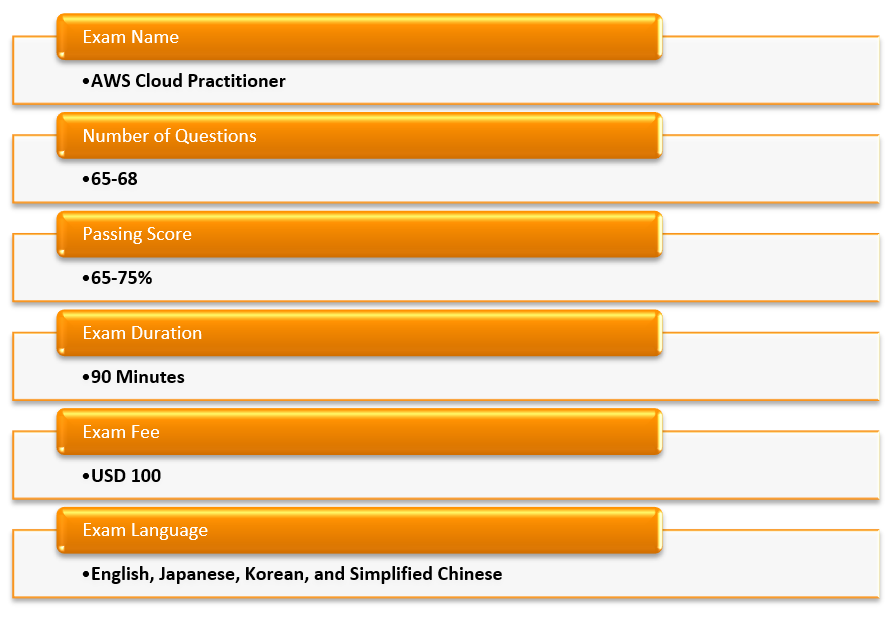
Finally, you’re all done with the exam details and information. Now that you’re all equipped with an exam overview, it’s time for your next crucial step. Yes, it’s none other than the Exam Guide aka the Course Outline. This constitutes the most important section of the exam. So, try not to skip this section. In other words, this is the heart of the examination. Now, you get it, it’s that important.
AWS Certified Cloud Practitioner (CLF-C02) Exam Guide
This exam guide comprises of weightage of domains, all the subdomains, and objectives. It is not just a comprehensive listing of the content on this examination. But, the table below illustrates the main content domains and their weightage in the CLF-C02 Exam.

Domain 1: Cloud Concepts
1.1 Define the AWS Cloud and its value proposition
- Define the benefits of the AWS cloud including:
- Security (AWS Documentation: Advantages of Cloud Security)
- Reliability (AWS Documentation: Reliability)
- High Availability
- Elasticity (AWS Documentation: Elasticity)
- Agility
- Pay-as-you go pricing (AWS Documentation: AWS Pricing)
- Scalability
- Global Reach
- Economy of scale
- Explain how the AWS cloud allows users to focus on business value
- Shifting technical resources to revenue-generating activities as opposed to managing infrastructure (AWS Documentation: Business Value on AWS)
1.2 Identify aspects of AWS Cloud economics
- Define items that would be part of a Total Cost of Ownership proposal
- Understand the role of operational expenses (OpEx)
- Understand the role of capital expenses (CapEx)
- Understand labor costs associated with on-premises operations (AWS Documentation: AWS Pricing/TCO Tools)
- Understand the impact of software licensing costs when moving to the cloud (AWS Documentation: Cost and licensing)
- Identify which operations will reduce costs by moving to the cloud
- Right-sized infrastructure (AWS Documentation: Right Sizing)
- Benefits of automation (AWS Documentation: Automation, Investing in Cloud Automation)
- Reduce compliance scope (for example, reporting) (AWS Documentation: Minimizing the PCI Compliance Burden Using Containerization, Microservices, and AWS)
- Managed services (for example, RDS, ECS, EKS, DynamoDB) (AWS Documentation: AWS Managed Services)
1.3 Explain the different cloud architecture design principles
- Explain the design principles
- Design for failure (AWS Documentation: Design for Failure)
- Decouple components versus monolithic architecture (AWS Documentation: Decomposing monoliths into microservices)
- Implement elasticity in the cloud versus on-premises (AWS Documentation: Elasticity)
- Think parallel
Domain 2: Security and Compliance
2.1 Define the AWS shared responsibility model
- Recognize the elements of the Shared Responsibility Model (AWS Documentation: Shared Responsibility Model)
- Describe the customer’s responsibility on AWS
- Describe how the customer’s responsibilities may shift depending on the service used (for example with RDS, Lambda, or EC2) (AWS Documentation: Shared Responsibility, Shared Responsibility Model)
- Describe AWS responsibilities Shared Responsibility Model)
2.2 Define AWS Cloud security and compliance concepts
- Identify where to find AWS compliance information (AWS Documentation:AWS Compliance Programs, Compliance Resources)
- Locations of lists of recognized available compliance controls (for example, HIPPA, SOCs) (AWS Documentation: HIPAA, SOC)
- Recognize that compliance requirements vary among AWS services (AWS Documentation: Security and compliance)
- At a high level, describe how customers achieve compliance on AWS (AWS Documentation:AWS Compliance)
- Identify different encryption options on AWS (for example, In transit, At rest) (AWS Documentation: Encryption of Data in Transit, Encryption of Data at Rest)
- Describe who enables encryption on AWS for a given service (AWS Documentation: importance of encryption and how AWS can help)
- Recognize there are services that will aid in auditing and reporting (AWS Documentation:AWS Audit Manager)
- Recognize that logs exist for auditing and monitoring (do not have to understand the logs) (AWS Documentation: Viewing HSM audit logs in CloudWatch Logs)
- Define Amazon CloudWatch, AWS Config, and AWS CloudTrail (AWS Documentation: Amazon CloudWatch, AWS Config, AWS CloudTrail)
- Explain the concept of least privileged access (AWS Documentation: Security best practices in IAM)
2.3 Identify AWS access management capabilities
- Understand the purpose of User and Identity Management
- Access keys and password policies (rotation, complexity) (AWS Documentation: Managing access keys for IAM users, Setting an account password policy for IAM users)
- Multi-Factor Authentication (MFA) (AWS Documentation: Using multi-factor authentication (MFA) in AWS)
- AWS Identity and Access Management (IAM) (AWS Documentation:AWS Identity and Access Management (IAM))
- Groups/users (AWS Documentation: IAM Identities (users, user groups, and roles))
- Roles (AWS Documentation: IAM roles)
- Policies, managed policies compared to custom policies (AWS Documentation: Policies and permissions in IAM, AWS managed policies)
- Tasks that require use of root accounts (AWS Documentation: AWS account root user credentials and IAM user credentials)
- Protection of root accounts (AWS Documentation: best practices for securing my AWS account)
2.4 Identify resources for security support
- Recognize there are different network security capabilities
- Native AWS services (for example, security groups, Network ACLs, AWS WAF) (AWS Documentation: Control traffic to subnets using Network ACLs, Control traffic to resources using security groups, AWS WAF)
- 3rd party security products from the AWS Marketplace
- Recognize there is documentation and where to find it (for example, best practices, whitepapers, official documents)
- AWS Knowledge Center, Security Center, security forum, and security blogs (AWS Documentation: AWS Knowledge Center)
- Partner Systems Integrators (AWS Documentation: Next-Gen MSP Meets Global Systems Integrator on AWS)
- Know that security checks are a component of AWS Trusted Advisor (AWS Documentation: AWS Trusted Advisor check reference)
Domain 3: Technology
3.1 Define methods of deploying and operating in the AWS Cloud
- Identify at a high level different ways of provisioning and operating in the AWS cloud
- Programmatic access, APIs, SDKs, AWS Management Console, CLI, Infrastructure as Code (AWS Documentation: AWS APIs, AWS SDK for JavaScript, AWS Management Console, AWS Command Line Interface, Infrastructure as Code)
- Identify different types of cloud deployment models
- All in with cloud/cloud native (AWS Documentation: Cloud-Native)
- Hybrid (AWS Documentation: Hybrid Cloud with AWS)
- On-premises (AWS Documentation: Deployments on an EC2/On-Premises Compute Platform)
- Identify connectivity options
- VPN (AWS Documentation: AWS VPN)
- AWS Direct Connect (AWS Documentation: AWS Direct Connect)
- Public internet (AWS Documentation: Connect to the internet using an internet gateway)
3.2 Define the AWS global infrastructure
- Describe the relationships among Regions, Availability Zones, and Edge Locations (AWS Documentation: Regions and Zones, Regions and Availability Zones)
- Describe how to achieve high availability through the use of multiple Availability Zones
- Recall that high availability is achieved by using multiple Availability Zones (AWS Documentation: Multi-AZ deployments for high availability, Amazon RDS Multi-AZ)
- Recognize that Availability Zones do not share single points of failure
- Describe when to consider the use of multiple AWS Regions (AWS Documentation:Multi-Region Application Architecture)
- Disaster recovery/business continuity (AWS Documentation: Disaster recovery options in the cloud, Business Continuity Plan (BCP))
- Low latency for end-users (AWS Documentation: Low-latency computing with AWS Local Zones)
- Data sovereignty (AWS Documentation: Embrace Data Sovereignty)
- Describe at a high level the benefits of Edge Locations (AWS Documentation:AWS for the Edge)
- Amazon CloudFront (AWS Documentation: Amazon CloudFront)
- AWS Global Accelerator (AWS Documentation: AWS Global Accelerator)
3.3 Identify the core AWS services
- Describe the categories of services on AWS (compute, storage, network, database) (AWS Documentation: AWS Cloud Products)
- Identify AWS compute services
- Recognize there are different compute families (AWS Documentation: Amazon EC2 Instance Types)
- Recognize the different services that provide compute (for example, AWS Lambda compared to Amazon Elastic Container Service (Amazon ECS), or Amazon EC2, etc.) (AWS Documentation: Compute Services)
- Recognize that elasticity is achieved through Auto Scaling
- Identify the purpose of load balancers (AWS Documentation: Application Load Balancer)
- Identify different AWS storage services
- Describe Amazon S3 (AWS Documentation: Amazon S3)
- Describe Amazon Elastic Block Store (Amazon EBS) (AWS Documentation: Amazon Elastic Block Store (Amazon EBS))
- Describe Amazon S3 Glacier (AWS Documentation: Amazon S3 Glacier)
- Describe AWS Snowball (AWS Documentation: AWS Snowball)
- Describe Amazon Elastic File System (Amazon EFS) (AWS Documentation: Use Amazon EFS with Amazon EC2)
- Describe AWS Storage Gateway (AWS Documentation: Amazon S3 File Gateway)
- Identify AWS networking services
- Identify VPC (AWS Documentation: Finding information to connect to a VPC)
- Identify security groups (AWS Documentation: Finding information to connect to a VPC)
- Identify the purpose of Amazon Route 53 (AWS Documentation: Amazon Route 53)
- Identify VPN, AWS Direct Connect (AWS Documentation: Identifying a Site-to-Site VPN connection, AWS Direct Connect)
- Identify different AWS database services
- Install databases on Amazon EC2 compared to AWS managed databases (AWS Documentation: Choosing between Amazon RDS, Amazon EC2, or VMware Cloud)
- Identify Amazon RDS (AWS Documentation: Amazon RDS DB instances)
- Identify Amazon DynamoDB (AWS Documentation: Amazon DynamoDB)
- Identify Amazon Redshift (AWS Documentation: Getting started with Amazon Redshift)
3.4 Identify resources for technology support
- Recognize there is documentation (best practices, whitepapers, AWS Knowledge Center, forums, blogs) (AWS Documentation: Follow Security Best Practices, AWS Knowledge Center, AWS Whitepapers & Guides)
- Identify the various levels and scope of AWS support
- AWS Abuse (AWS Documentation: report abuse of AWS resources)
- AWS support cases (AWS Documentation: Creating support cases and case management)
- Premium support
- Technical Account Managers (AWS Documentation: AWS Enterprise Support)
- Recognize there is a partner network (marketplace, third-party) including Independent Software Vendors and System Integrators (AWS Documentation: AWS Partner Network, AWS Partner Paths)
- Identify sources of AWS technical assistance and knowledge including professional services, solution architects, training and certification, and the Amazon Partner Network (AWS Documentation: technical support from AWS, AWS Professional Services, Successful solutions architects do these five things)
- Identify the benefits of using AWS Trusted Advisor (AWS Documentation: AWS Trusted Advisor)
Domain 4: Billing and Pricing
4.1 Compare and contrast the various pricing models for AWS (for example, On-Demand Instances, Reserved Instances, and Spot Instance pricing) (AWS Documentation: Amazon EC2 pricing)
- Identify scenarios/best fit for On-Demand Instance pricing (AWS Documentation: Amazon EC2 On-Demand Pricing, On-Demand Instances)
- Identify scenarios/best fit for Reserved-Instance pricing (AWS Documentation:Reserved Instances, Amazon EC2 Reserved Instances)
- Describe Reserved-Instances flexibility (AWS Documentation: Instance Size Flexibility for EC2 Reserved Instances)
- Describe Reserved-Instances behavior in AWS Organizations (AWS Documentation: Reserved Instances)
- Identify scenarios/best fit for Spot Instance pricing (AWS Documentation: Spot Instances)
4.2 Recognize the various account structures in relation to AWS billing and pricing
- Recognize that consolidated billing is a feature of AWS Organizations (AWS Documentation: Consolidated billing for AWS Organizations)
- Identify how multiple accounts aid in allocating costs across departments (AWS Documentation: AWS Cost Allocation For Customer Bills, Cost Allocation Basics)
4.3 Identify resources available for billing support
- Identify ways to get billing support and information (AWS Documentation:AWS Billing and Cost Management)
- Cost Explorer, AWS Cost and Usage Report, Amazon QuickSight, third-party partners, and AWS Marketplace tools (AWS Documentation: Analyzing your costs with AWS Cost Explorer, AWS Cost and Usage Reports, Amazon QuickSight, AWS Managed Service Provider Partners)
- Open a billing support case (AWS Documentation: Creating support cases and case management)
- The role of the Concierge for AWS Enterprise Support Plan customers (AWS Documentation: AWS Enterprise Support)
- Identify where to find pricing information on AWS services
- AWS Simple Monthly Calculator (AWS Documentation: AWS Pricing Calculator console)
- AWS Services product pages (AWS Documentation: Using the Products page)
- AWS Pricing API (AWS Documentation: AWS Price List API)
- Recognize that alarms/alerts exist (AWS Documentation: Creating a billing alarm to monitor your estimated AWS charges)
- Identify how tags are used in cost allocation (AWS Documentation: Using Cost Allocation Tags)
Since this a foundation-level Exam, hence the Course Outline mentioned above is petite. Certainly, this is an advantage for you. So, now it’s time for you to buckle up and pay attention to the part you’ve been waiting for.
Preparatory Guide for AWS Cloud Practitioner
Just to clarify, the CLF-C02 Exam is not a difficult exam. That clearly implies that you can easily clear the exam and acquire the certification. However, not prepping for the exam will unquestionably result in a tragedy for obvious reasons. Therefore, we highly recommend going through our step by step routine for an excellent result.
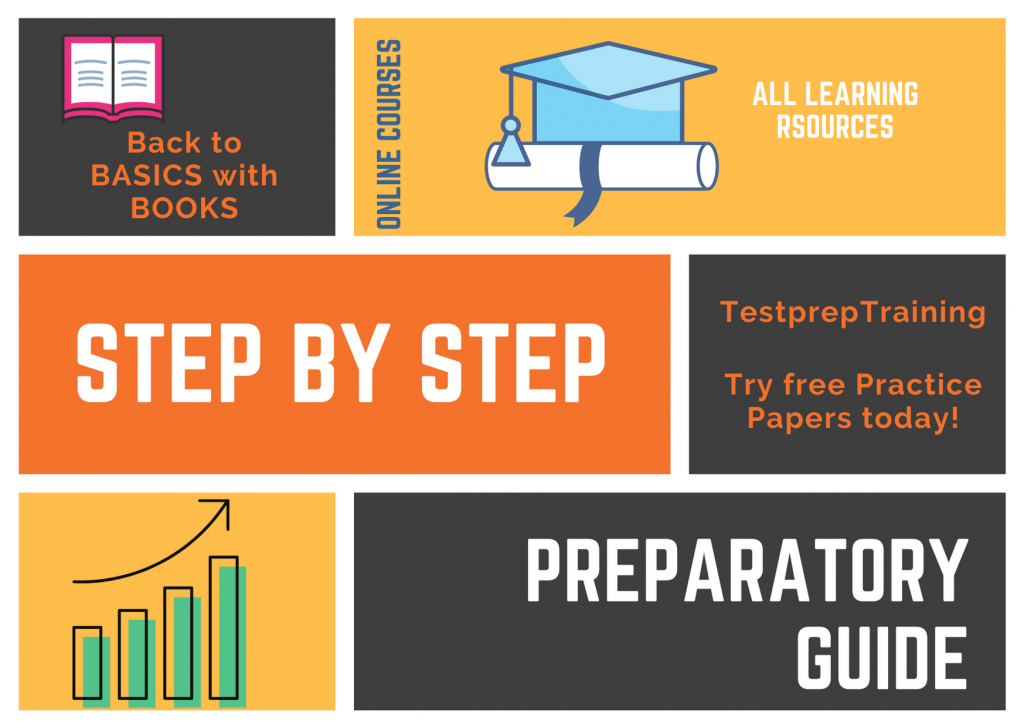
1. Review all Exam Objectives
Before, venturing on any journey, one must have a clear idea of what he/she is putting themselves into. With that being said, reviewing each and every exam objective becomes the most important part of your preparation. So, make sure you visit the Official website of AWS, to have a clear view. Since it is the most authentic site to provide any information regarding the CLF-C02 Exam. After you’ve gone through the basic exam details. It’s time to hit the AWS Cloud Practitioner Study Guide.
2. Exploring AWS Learning Paths
Now that you have downloaded the course outline, it’s time for you to go through AWS Learning Paths. This particular step will ensure that you have a great foundation before real learning begins. In other words, acquiring prior knowledge will be like groundwork. Therefore, make sure to go through the following AWS Cloud Practitioner training paths-
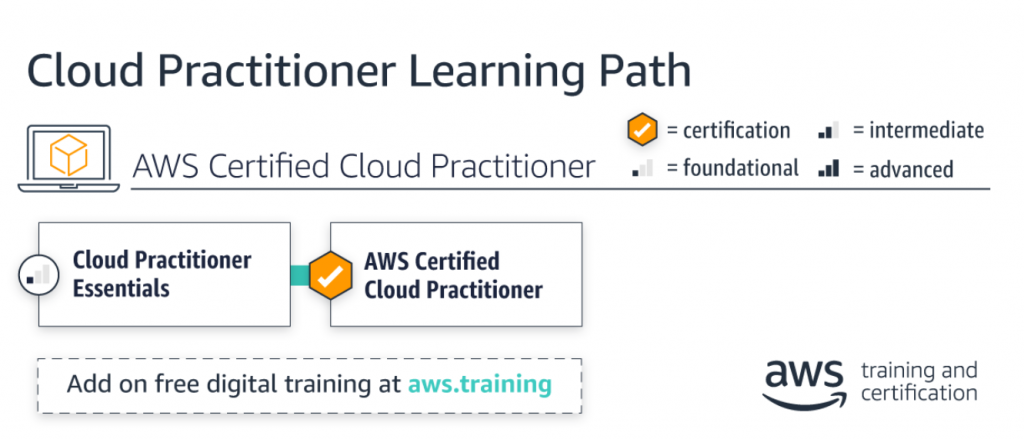
3. AWS Cloud Practitioner Essentials (Classroom)
This is fundamental-level, one-day, instructor-led classroom course. After this, the candidate learn the following –
- First thing first, defining what the cloud is and how it works
- Secondly, differentiate between cloud computing and deployment models
- Subsequently, describe the AWS Cloud value proposition
- Also, describe the basic global infrastructure of the cloud
- Further, compare the different methods of interacting with AWS
- And, describe and differentiate between AWS service domains
- Not to mention, identify an appropriate solution using AWS Cloud services
- Moreover, describe the Well-Architected Framework
- Additionally, describe basic AWS Cloud architectural principles
- Furthermore, Explain the Shared Responsibility model
- In the same vein, describe security services with the AWS cloud
- Further, define the billing, account management, and pricing models for the AWS platform
- Lastly, identify future services and developments built on the cloud
4. AWS Cloud Practitioner Essentials (Second Edition)
This is a free digital course to understand the fundamentals of the AWS Cloud, build cloud skills, and prepare for the AWS Certified Cloud Practitioner exam. After this, the candidate will learn to do the following-
- Firstly, define what the AWS Cloud is and the basic global infrastructure
- Secondly, describe the key services on the AWS platform and their common use cases
- Thirdly, describe basic AWS Cloud architectural principles
- Subsequently, describe basic security and compliance aspects of the AWS platform and the shared security model
- Consequently, define the billing, account management, and pricing models
- And, identify sources of documentation or technical assistance (e.g., whitepapers, support tickets)
- Also, describe the AWS Cloud value proposition
- Furthermore, describe basic/core characteristics of deploying and operating in the AWS Cloud
5. Recommended AWS Knowledge
It is recommended that candidates must have at least 6 months of experience with the AWS Cloud in any role. Further, this includes traditional and non-traditional candidates, educators, and individuals exploring the AWS Cloud, including project managers, IT managers, sales managers, decision-makers, and marketers, as well as those working in finance, procurement, and legal departments.
Apart from this, a candidate must have a general IT Knowledge. This includes, having a basic understanding of IT services and their uses in the AWS Cloud platform.
AWS Certified Advanced Networking Specialty Study Guide
6. Online Courses
If a candidate wishes to join an Online Course for the same. There are various courses available online. In fact, the internet is cluttered with so many courses. So, makes sure to find a suitable course, which is available in your price range. These courses provide you with online video study material, that can get digested easily. Also, they even provide the candidate with sample papers. So, you can try them out.
7. Read AWS Whitepapers
After, this you must go through AWS whitepapers. With these, you will expand your knowledge of the cloud with AWS technical content. Also, you’ll find various technical whitepapers, technical guides, reference material, and reference architecture diagrams. But, we have narrowed it down to the following. So, make sure to go through the following-
- Overview of Amazon Web Services
- Architecting for the Cloud: AWS Best Practices
- How AWS Pricing Works
- Compare AWS Support Plans
8. AWS Reference Books
There are many reference books that are available for the AWS Cloud Practitioner Certification Exam. And, the few good ones are,
- The Beginners Guide to Amazon Web Services book by Dennis Hutten
- AWS Cloud Practitioner Study Guide book by Ben Piper, David Clinton
- AWS Basics: Beginner’s Guide book by Gordon Wong
- Certified Cloud Practitioner Certification Guide book by Todd Montgomery
- Amazon Web Services for Dummies-by Bernard Golden
9. Join the Community/ Online Forum
Online forums and study groups are a great way to prepare for the certification exam. Therefore, feel free to get in touch with other candidates through study forums or online groups to ask a question related to the topic you’re having difficulty with.
However, it’s not something you have to join. It’s just something very subjective. Not to mention, these online groups help you stay equated with the other people who are also walking through the same path as yours. Moreover, you can also ask a question related to the topic you’re having difficulty with.
10. Self-evaluation Time
Finally, we’re on the last step for the preparatory guide. Further, this final step will give the candidate the exact insight of the topics in which they’re lacking. So, make sure you’re going through sample tests after you have gone through the entire syllabus. Most importantly, all the practice tests are designed to encounter the real exam environment around you. However, practice papers can be from various sources. Above all, remember the more you test yourself the better you’re going to become. SO START PRACTICING NOW!
Tips and Tricks directly from Experts:
Taking the certification exam is no fun. There’s a reason it’s a common nightmare for anyone that’s ever been in university, even briefly. This goes double for AWS exams which are a big investment in terms of time and preparation.
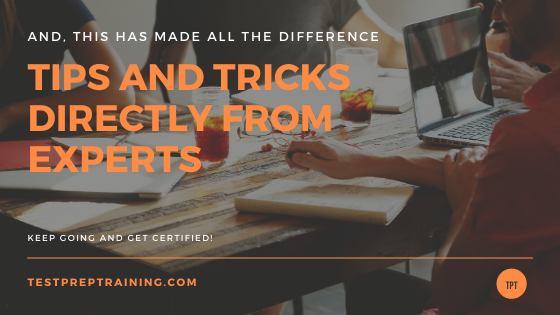
- First of all, understand, never use brain dumps. Make sure to avoid brain dumps. They won’t help you with the preparation.
- Secondly, make sure to memorize the exam objectives. Further, this will provide you with a clear vision.
- Subsequently, while preparing for the examination, make sure you understand what type of learner you are. No two individuals are the same, therefore understand your learning habits.
- Moreover, make sure you go through as much practice sets as possible. This help you learn better.
- Not to mention, if possible try to join an online community. Mark our words, this will be worth it.
- Also, try to plan your time according to your schedule. So that you have enough time on your hand and there are no gap between your preparation.
- Consequently, make sure to view at the multiple-choice question tricks.
- Last but not least, make sure to treat yourself well on the day of the exam.
Closing Thoughts
In the end, we would like to mention that the certifications are designed to identify the candidate’s ability to assist management. Also, their ability to improve the quality of information systems within the specialization. And, the framework of any profession is the body of knowledge what a candidate possesses.
As for the preparation part, candidates should avoid last-minute cramming sessions as it is rarely beneficial in the long term. If your experience is minimal or is limited to only certain areas of those related knowledge domains, then you should go for the study materials mentioned above in the guide to broaden your knowledge. And, we’re sure that you will be able to qualify the examination in the very first attempt.

Make your resume stand out and become an AWS Certified Cloud Practitioner. Try free practice tests here!

